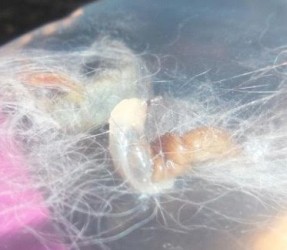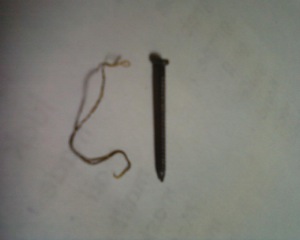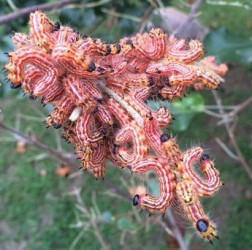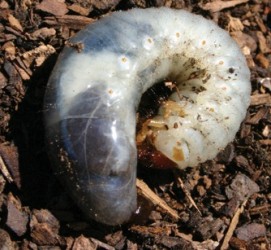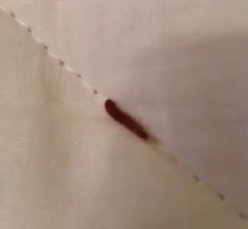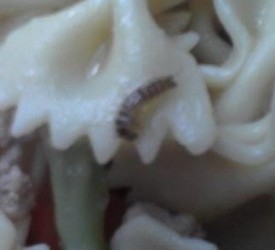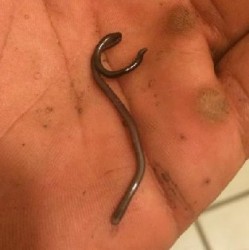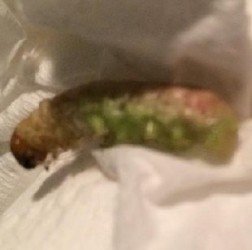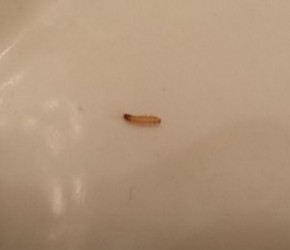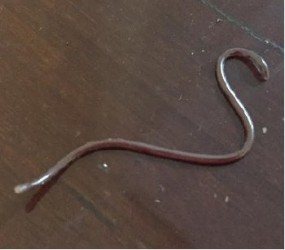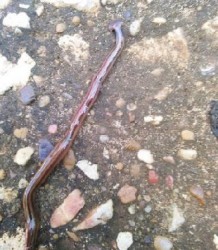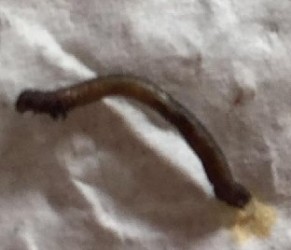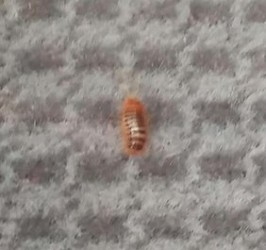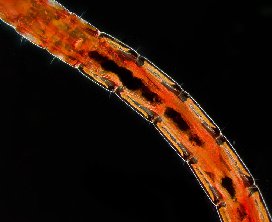Author: Worm Researcher Evan
Earthworms in the Shower?
A reader wrote to us recently about some worms that she found in her shower. As she notes, they look like earthworms, but they are “smaller and thinner.” The reader is uncertain how they ended up in her shower, but she offers some speculation: they might have come from the drain, or she might have brought them in herself, maybe in her hair, as she took a shower after taking a hike. Our reader is wondering what she found, and she is also wondering if she should be worried about the worms that turned up in her shower.
Worms Caught in Cat Hair
We received a puzzling question recently about some worms that our reader found in the hair of her cat. The worms (or whatever they are) have been caught in the cat’s hair on a couple of different occasions, and the reader is concerned that they might be harmful to her cat in one way or another. They might just be getting caught in the cat’s fur, posing no threat, but they also might be “something worse feeding off him [the cat].” The reader offers a lot of information and a picture, so we’ll try to make some sense of the situation with what we were presented with.
Long, Red Worms in the Toilet
We recently received a question through the All About Worms Facebook page about “two red worms in the toilet bowl.” The worms were “10 cm long, thin, like one millimeter in diameter, and alive, even in the water, they were still moving.” The reader didn’t actually ask for an identification, but instead asked if the worms might be parasites. This is his main concern, and we will focus on this question, although the answer is of course tied to what exactly the reader found, so we’ll touch on the matter of identification as well. What might the red worm in the toilet be, and are they parasitic?
Red and Orange Caterpillar on Apple Trees
We received a question through the All About Worms Facebook page about red and orange caterpillars that a reader recently found on an apple tree. To call them “red and orange caterpillars” is at once insufficient and overreaching. It is insufficient because the creatures aren’t only red and orange; they have black heads and legs, and some orange parts of their bodies might just as easily be described as yellow. White hairs also cover their bodies, and they are striped lengthwise, from head to tail. We overreach, however, in claiming without explanation that these creatures are caterpillars. The reader identifies them as worms, so we must explain why we think they are instead caterpillars. This explanation is of course tied to the matter of identification, which is what the reader is wondering about, and to that topic we now turn.
Worm or Larva on Lawn that Makes Noises?
We received an interesting question from a reader through the All About Worms Facebook page about a “greenish grey worm” that his cat found on his lawn. The worm (or probably larva) is “2-3 inches long and had rings around it so he looked like a bunch of inter-tubes stacked on each other.” However, the defining characteristic of the creature is that it made noise. The reader was wondering what kind of worm or larva he (or technically his cat) found.
Carpet Beetle Larvae or Bed Bugs in the Apartment?
A couple of days ago we received a question through the All About Worms Facebook page from a reader who recently moved into an apartment in Valencia, Spain. Unfortunately, his girlfriend has been waking up with bite marks that look like they might be the work of bed bugs. However, both the reader and an expert could find no trace of bed bugs in the apartment. This led our reader to speculate that he might have found carpet beetle larvae, as these larvae have small hairs that can cause skin irritation that look like bed bug bites, just as the reader noted. He sent us a few videos and asked us to comment on the matter.
Small Worm or Larva in Soup
A reader recently wrote to us about what appears to be a small larva that she found in her soup. (We mentioned a possible “worm” in the soup only because people so often call larvae “worms.”) The reader is wondering what she found, and she also asked if she should be concerned if she accidentally ate one. We’ll tackle each question in turn, suggesting a possible identification and then discussing eating larvae, both in general and as it relates to the reader’s specific circumstances.
Worms or Larvae on Dogwood Trees
A reader asked us through the All About Worms Facebook page about “white worms with yellow bottoms [that are] eating my Dogwood trees.” These white worms with yellow bottoms are very likely white larvae with yellow bottoms, so we’ll adjust our usage accordingly. The reader asked us for an identification, and we’ll largely limit ourselves to this specific matter to keep things short and simple.
Worms or Larvae in Cat Food Dish
Via the All About Worms Facebook page, we received a message from a reader who found about 15 to 20 “worms” in her cat’s food dish. These “worms” are almost certainly insect larvae, so we’ll go ahead and refer to the larvae in the cat food from here on out. In addition to the cat food dish, the larvae were found in the bag of cat food, and in fact this is probably their point of origin, as various types of larvae will infest bags of pet food. The reader also indicated that one of her cats threw up the other night, but it isn’t clear if this is connected to the pet food larvae. No specific questions were asked, but the reader indicated “any info will be tremendously helpful,” so we’ll offer what we can and hope that it helps.
Fat Black Larvae in RV
A reader wrote to us recently about some plump black larvae he has been finding in his RV after a water leak. At first he only found the larvae under his trashcan, but he has since spotted them in other parts of his RV – “on the bathroom floor and the carpet and around the seams where carpet stops.” We are pretty certain our reader is finding black soldier fly larvae, but that only addresses the first of his three questions. He is also wondering why the larvae are in his RV, and also how to get rid of them.
Smooth, Gray Worms
Recently a reader sent us a picture of a smooth, gray worm that he is holding in the palm of his hand. Presumably, the reader found the worm and is wondering what it is, but this is conjecture since we were sent the picture with no accompanying text (apart from “sent from my iPhone.”) We therefore don’t know where, or in what circumstances, this worm was found, and obviously this makes identification more difficult, but the picture is good, so we’ll do what we can with that.
Grub Worms in the House
We received a question from a reader who found some sort of larvae in his house. One was found in the hallway, and the other was found on the carpet by the baseboard. The reader says the larvae are white and red on top and green on the bottom, and this can more or less be seen in the photo he submitted along with his question. The reader also reports that the larvae has eight to ten legs. We think our reader found grub worms, which aren’t worms but scarab beetle larvae, so that answers one of his questions. However, he was also curious where the larvae came from, so we’ll address this topic as well.
Tiny White Maggots in Bathroom
We received a question from a reader recently about a small maggot, or something like a maggot, that he found in his bathroom. The reader’s email to us does a decent job covering his situation, so we’ll quote it in full (with the addition of several articles, definite and indefinite): “This tiny white maggoty looking worm with light pinkish head and tail was on the edge of my bathroom sink this morning. My shitzu sleeps with me. Maybe it crawled on me in the night and fell off me at the sink? He goes potty in a woodsy area. I know there are chiggers he brings in. I’m in west central Missouri. Just north of Kansas City and it’s the end of June. Can you identify? Thank you.”
Scary, Fast Worm on Bathroom Floor
A reader wrote to us recently about a “scary looking really fast moving worm on my bathroom floor.” Emphasizing its speed once more, the reader reports that the worm, which is actually most likely a centipede (more on this in a second), “moved really fast even on a wet floor,” and also mentioned that it crawled up into the wall after it was spotted. The reader was quite startled by the worm (or centipede), and asked for our help. Obviously, we aren’t in position to help in any sort of direct way, but we can help with the matter of identification, and again we think our reader found a centipede, not a worm, for reasons we will now outline.
Worm on Floor in Singapore
A reader recently sent us a great picture of a worm he found in Singapore on his hardwood floor. The worm is relatively long and skinny, and its body color might be roughly described as translucently gray. Overall, it is a fairly nondescript creature – not in the sense that it isn’t interesting looking, but only because it doesn’t have any clear markings or body features. Its plainness is almost an aesthetic onto itself. What is this worm on the floor in Singapore?
Fishing with Hammerhead Worms
We recently received a question from a reader about whether or not it is possible to fish with hammerhead worms. The reader didn’t actually ask about hammerhead worms specifically, but she sent us a picture of what we are basically certain is a hammerhead worm, and then asked if she can fish with it. We’ll first provide some basic information about these creatures, and then we’ll move on to the more specific topic of fishing with hammerhead worms.
Worm Crawling on Head
A reader sent us a question the other day about a worm, or what “seems to be a worm,” that was found on her mother’s head. The reader went through quite a bit of trouble to figure out what she found, researching online and consulting her notes from a zoology class, but she couldn’t figure out what was on her mom’s head. She therefore wrote to us, hoping that we might be able to help with the matter of identification.
Worms in Carpet and Clothing
A reader wrote to us the other day about “carpet worms, carpet beetles, and possibly a moth worm” that she has seen moving in her carpet. The worms and beetles, which we’ll define more precisely below, are also eating holes in her shirt and “causing” lint to build up. The infestation has gotten so bad that the reader feel pricks when she walks around the carpet. For obvious reasons, she wants to get of the worms and beetles she is finding, and she wrote to us for help.
Small Worm with Red Bodies and Tan Heads in the Kitchen
A reader wrote to us recently to ask about two worms she found in her kitchen. The worms have red bodies and tan heads, and they are perhaps a half an inch (one centimeter) long. The reader isn’t particularly concerned with what they are, and is instead focused on the question of where they came from. She has no indoor houseplants, and her windows and doors have been closed. She also says she has no food, but it is hard to take this literally, so perhaps she just doesn’t have food that is laying around the kitchen. As the reader points out, though, these two worms must of come from somewhere, and where might that be?
Worm Picking: The Multi-Million Dollar Hunt for Bloodworms
Unless you are a fisherman who lives along the Northeastern coast of the U.S., there is a good chance you haven’t heard of worm picking or worm digging, at least not as a profession. However, worm picking, or the gathering of bloodworms to be sold as fish bait, is a multi-million dollar industry with thousands of licensed practitioners. In any given year, hundreds of thousands of pounds of worms are gathered and sold. But before you quit your job and head northeast to strike it rich, you should know that worm picking can be a brutally difficult job that is really not that remunerative. A lot of luck is involved, and the competition for worms can be fierce. It is also potentially dangerous since a bloodworm bite can cause an allergic reaction.

